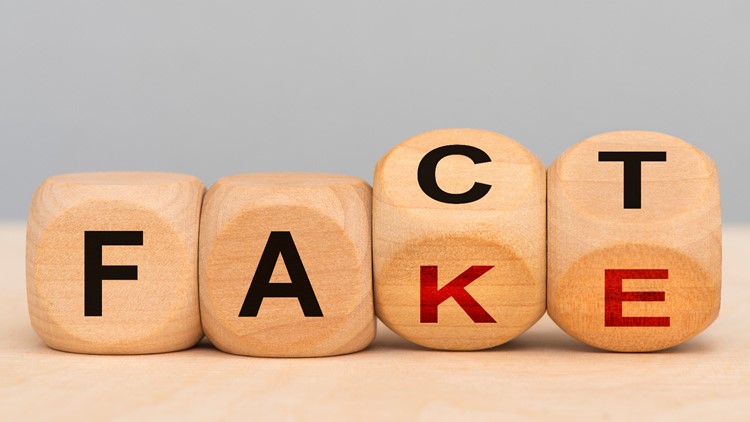April 2 marks International Fact-Checking Day, which is devoted to debunking misinformation and celebrating the people who help spread the truth.
VERIFY is dedicated to helping our readers distinguish between true and false information. But have you ever wondered if there are ways you can VERIFY claims you see before hitting that “share” or “retweet” button?
We compiled five tips to help you fact-check for yourself.
THE SOURCES
- Syracuse University’s School of Information Studies
- Ohio University
- Johns Hopkins University
- AARP
- Kaspersky, a cybersecurity company
- Barbara Gray, chief librarian and associate professor at the City University of New York (CUNY) Graduate School of Journalism
WHAT WE FOUND
1. Consider the source.
One of the most important steps in fact-checking is considering the source of the claim.
Here are five questions you can ask yourself:
Who’s the author? Syracuse University’s School of Information Studies recommends asking yourself whether the author is credible enough to speak to the topic, and looking for other content or posts they have produced in the past. You can also check out a social media account to see if it shows qualities associated with bots, or automated “users” that are created to mimic human behavior through a computer.
Is the author or news source biased? You should be on the lookout for stories or posts that only present one side of a debate. Joe Carrigan, senior security engineer at the Johns Hopkins University Information Security Institute, recommends using tools like AllSides that categorize and understand the biases of news organizations.
Does the author cite their sources? Credible sources should always include their external sources of information to back up claims, Ohio University says in its guide to misinformation and fact-checking.
Is this a well-known or legitimate website? Ohio University recommends asking yourself if you’ve heard of the website sharing the information. It’s also important to double-check the URL, as some people may try to mimic those of reputable websites. VERIFY has more tips for spotting malicious links here.
Is this account or website devoted to satire or parody? Some fake news is published by satirical websites or parody accounts for entertainment value, cybersecurity company Kaspersky says. If a social media account or website is devoted to satire or parody, they’ll often make note of it in their bio or “about” section.
2. Read beyond the headline.
Many people don’t read beyond the headline on articles they share online. People sharing fake or misleading information use that to their advantage by creating clickbait headlines that distort the truth, Emily Bell, founding director of the Tow Center for Digital Journalism at Columbia University, told AARP.
That’s why you should read the whole article, and not just the headline, before hitting that “share” or “retweet” button.
Here’s one example of a clickbait headline that VERIFY debunked in February 2023: “Scientists Warn Eggs Are Causing Thousands of People to ‘Suddenly’ Form Blood Clots.” That’s not true.
3. Check the date.
You should be able to see when an article or report was first published online or last updated. The more recent a report is, the better, according to Ohio University.
“The date of a source says a lot about whether or not the information is still relevant, factual, accurate or useful,” Ohio University says.
Old images or articles may recirculate on social media after disasters or other major events. That’s why it’s important to click on a link and check the date before sharing information.
4. Analyze the content.
You’ve probably heard the old adage: “If it seems too good to be true, it probably is.” That’s the case for what you see online, too, Syracuse’s School of Information Studies says.
For example, VERIFY recently looked into scam Facebook posts advertising tool sets from brands such as DEWALT with prices starting at $29.99. The sets typically sell for hundreds of dollars, which is one of the first indicators that these purported deals are a scam.
Syracuse also recommends analyzing content to look for pieces of information that are “inconsistent with others that you have read or seen, or seem overblown, dramatic or lacking specific evidence.”
Articles that make you angry or emotional may have been “manufactured or doctored to exploit your biases,” Barbara Gray, chief librarian and associate professor at the CUNY Graduate School of Journalism, says.
You should also look for primary sources cited in the reporting, such as original documents and recordings or a person with direct knowledge of a situation.
If you’re still unsure whether what you’ve just read is real, you can always conduct a Google search to see if the information is available on any other trusted sites or if it’s already been debunked.
5. Conduct a reverse image search
If you suspect a photo is fake, reverse image searches are a helpful way to find its original source and when it first appeared online.
There are several tools VERIFY uses to conduct reverse image searches: Google, RevEye and TinEye.
For example, VERIFY confirmed a photo claiming to show gridlocked traffic in Louisiana ahead of Hurricane Ida in 2021 was actually taken years earlier in Los Angeles. We used RevEye to trace the photo back to the Los Angeles Times, which credited a TV station with having taken it in 2017.
To conduct a reverse image search through Google from your computer, follow these steps:
1. Right-click on the photo in your Chrome browser and select “Search image with Google.” The results page will show you other places the image may have appeared.
2. You can also go to images.google.com on any browser, click on the camera icon, and upload an image that you’ve saved to your computer. This should also show a results page.
Google also has guides to reverse image searching from your iPhone or Android device.
RevEye is a browser extension you can install that also allows you to conduct a reverse image search by right-clicking any image online.
A website called TinEye also allows you to upload an image from your computer to find where it has appeared online.
If you have a question or claim you want us to VERIFY, email our team or fill out the form on our website in the “Want Something Verified?” box in the upper right corner.



